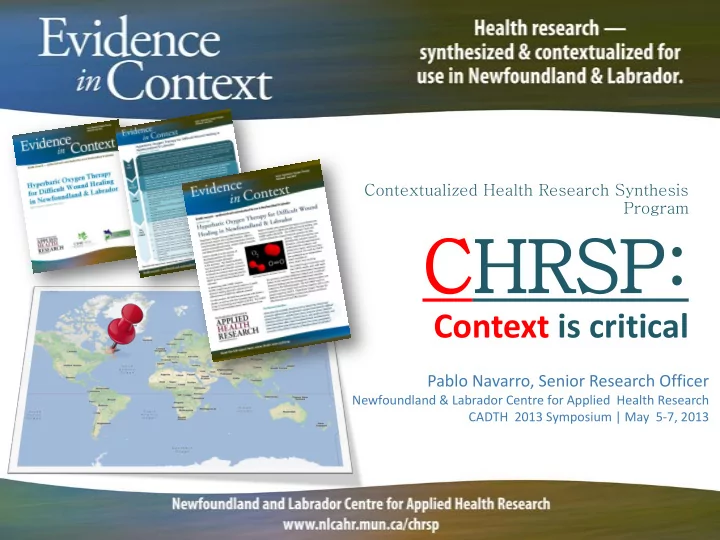

Contextualized Health Research Synthesis Program CHRSP: Context is critical Pablo Navarro, Senior Research Officer Newfoundland & Labrador Centre for Applied Health Research CADTH 2013 Symposium | May 5-7, 2013
Today’s Presentation 1. About NLCAHR & CHRSP 2. Evidence in Context: 3. Hyperbaric Oxygen Therapy for Non-Healing Wounds: a CHRSP project example 4. Findings > Contextualization 6. Dissemination & Follow Up 7. Concluding comments
About Established in 1999 by the provincial government, Memorial University and the Eastern Health regional health authority: to build research capacity to address priority research needs in NL to encourage evidence-informed health decisions
About CHRSP The challenge… …for researchers “ How can we get scientific evidence used more frequently and more effectively by the healthcare system? ” The CHRSP Partnership: …for the healthcare system: “ How can we find and use the best scientific evidence as one input among many into decision making? ”
1. What works? 2. What will work here?
CHRSP in a nutshell • Integrated KTE: o System leaders identify issues of importance o Issues formulated as a researchable question shaped to NL o Prioritize and categorize research questions o Engage decision makers throughout • Effective knowledge transfer & exchange: o Multiple report formats o Emphasis on implications for decision makers o Facilitate post-project engagement among stakeholders
Contextualization Overview CHRSP tailors its synthesis to 1. Topics of 2. CHRSP identifies the context of Newfoundland relevance contextual factors. & Labrador at all stages of the project 3. CHRSP interprets Contextual factors may effect findings in context. outcomes and/or cost effectiveness Contextual Factors: Patient populations Other System Factors Labrador Grenfell Health Site of service Economics and/or service design Politics Health human resources Central More about context here: Organization and delivery Health www.nlcahr.mun.ca/research/ of services chrsp/ Eastern Health
Contextualization Methodology Western DHCS Health Integrated KTE: beginning, middle and end Eastern of project, consultations NLCAHR Health with partners/stakeholders Labrador Central Grenfell Health Health
a contextualization example Hyperbaric Oxygen Therapy for Difficult Wound Healing in Newfoundland & Labrador CHRSP Health System Partner: Eastern Health CHRSP External Specialist: CADTH (Rhonda Boudreau, Research Officer; Kristen Moulton, Research Assistant; Sarah McGill, Information Specialist) CHRSP Team: Dr. Ken LeDez, Chair of the Discipline of Anesthesia, Memorial University Faculty of Medicine and Director of MEDICOR, Norma Baker, COO, Adult Acute Care for Eastern Health (now retired), Cathy Burke, Regional Director, Cardiac/Critical Care Program, Eastern Health, and Mary Bursey, Associate Professor in the School of Nursing at Memorial University.
HBOT in NL • Located at Health Sciences Centre • 1982: MEDICOR (MUN) for research and emergencies • Transferred to Eastern Health in 2010 • Multi-chamber facility (original) • Two mono-chambers (at transfer) • Broadened focus to include non- emergency conditions
CHRSP HBOT Project Background Belief that a significant number of patients may be suitable candidates for HBOT but are currently not receiving treatment
CHRSP HBOT Project Focus on non-healing wounds: • Diabetic foot ulcers • Delayed radiation-induced injuries • Severe burns • Skin grafts/flaps • Post-transplantation revascularization
CHRSP HBOT Project Partner with CADTH for Knowledge Synthesis
1. What works?
CHRSP Findings • HBOT is clinically effective and cost effective (societal perspective) for non- healing diabetic foot ulcers . • HBOT is clinically effective for some delayed radiation-induced injuries. • If referred appropriately and in a timely manner.
CHRSP Findings • Insufficient evidence to support or contradict HBOT for other studied conditions. • Lack of evidence means future research will have significant impact on evidence base.
CHRSP Findings • Overall cost-effectiveness of HBOT (when clinically effective) increases with increased use of the facility.
1. What works? 2. What will work here?
Contextualization: Patient Level • Geography & costs: challenges to completing full course of therapy for patients from far away*
Contextualization: Site of Service • Location: distant from related clinical sections of hospital
Contextualization: Human Resources • Training and safety: shortage of nurses and respiratory therapists
Contextualization: Organization • Appropriate referrals* • Wound care management integration*
Contextualization: Economic • Remuneration • Overtime
Contextualization: Political • Public expectations
Dissemination • Report (3 formats)
Dissemination • End of event, bring people together • Communications • Follow up
Decisions & Actions • Diabetes implications communicated to NLMA and others • Additional HBOT physician positions created and filled • Payment system adapted • Credentials system in process
Distinguishing features of CHRSP • focus on questions identified by system not the researchers • use both local and external expertise • build teams that combine researchers and decision makers • contextualize • work quickly • communicate effectively
Does CHRSP work?
It does. • topic selection complex but workable o each side has learned how to work together • contextualization is feasible and helpful • leading external experts fairly easy to recruit • teams work well together • the results have been produced fairly quickly • the results have actually been used: o dialysis decision template o Youth Residential Treatment planning o Single-use Medical Devices policy o considerations for development of PET o patient handling protocols in Eastern Health
Contact Us www.nlcahr.mun.ca/research/chrsp/ • Web: www.nlcahr.mun.ca • Phone: (709) 777-6993 • Email: nlcahr@mun.ca • Location: 95 Bonaventure Avenue, Suite 300
Recommend
More recommend